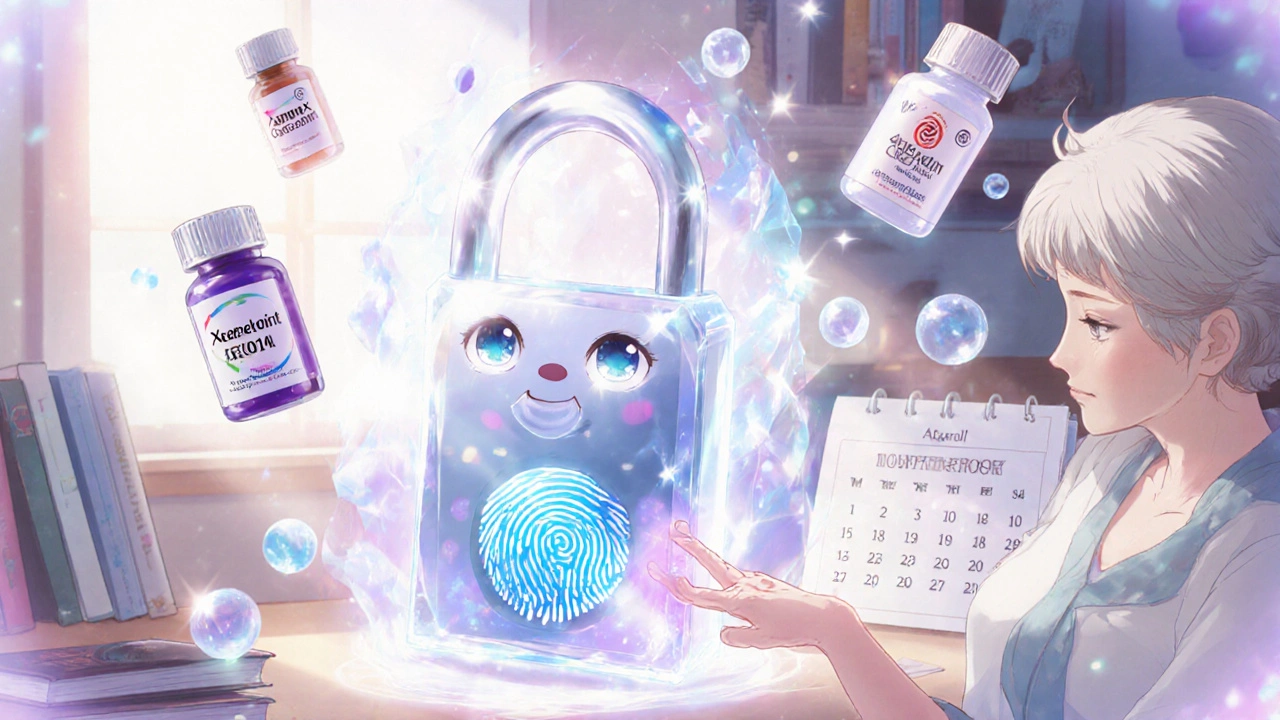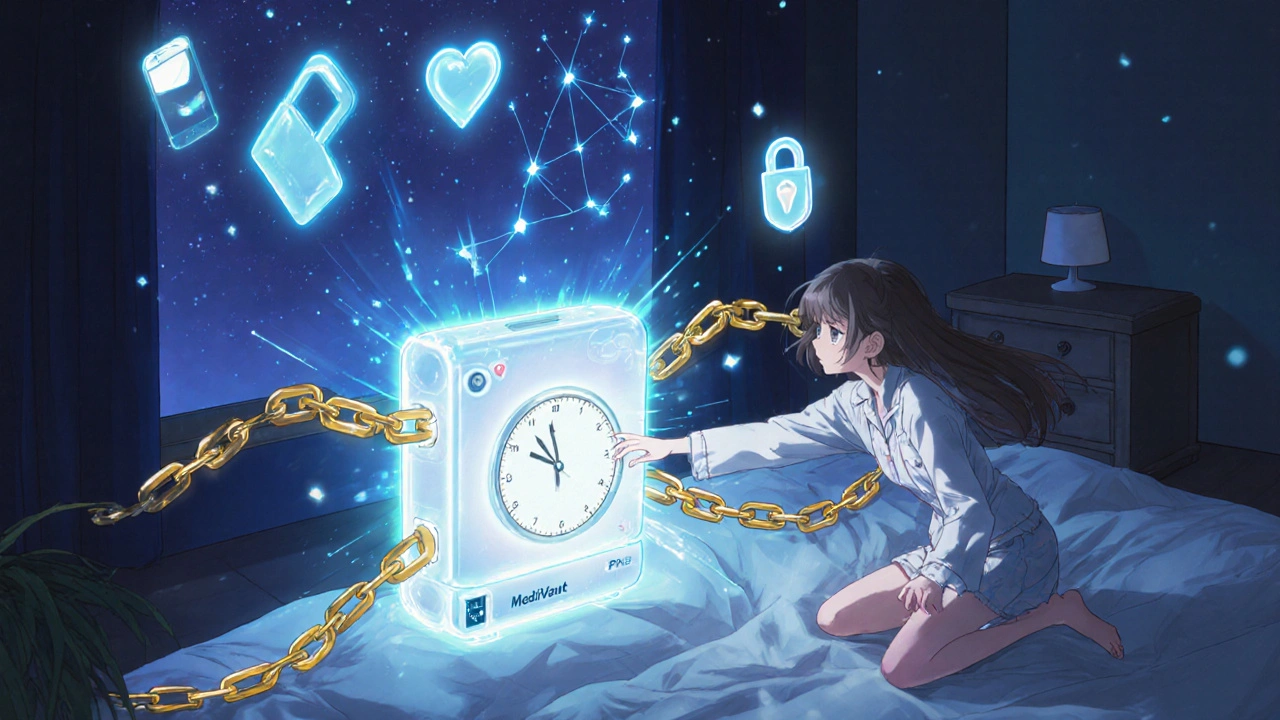 Nov, 20 2025
Nov, 20 2025
Every year, around 60,000 children end up in the emergency room because they got into medications left within reach. Most of these cases aren’t from stolen drugs or reckless behavior-they’re from simple accidents. A toddler finds a bottle on a nightstand. A teenager grabs a pill from the bathroom cabinet. A grandchild visits and opens a drawer that looks like it holds toys. These aren’t rare events. They happen in homes where people love their kids, their grandkids, and their own prescriptions-but didn’t know how to lock them away properly.
Why Lockboxes Are Necessary
Child-resistant caps sound like a good idea. They’re required by law for many prescriptions. But here’s the truth: half of all kids aged 4 to 5 can open them in under a minute. That’s not a flaw in the cap-it’s a flaw in relying on it alone. The CDC, the American Academy of Pediatrics, and the Substance Abuse and Mental Health Services Administration all agree: if you have high-risk medications at home, you need a lockbox. High-risk medications include opioids like hydrocodone (Vicodin, Norco), oxycodone (Percocet, OxyContin), benzodiazepines like alprazolam (Xanax), and stimulants like dextroamphetamine-amphetamine (Adderall). These aren’t just strong drugs-they’re dangerous if misused. Even a single pill can cause respiratory failure in a child. In adults, they can lead to addiction or overdose if taken without a prescription. A 2020 study found that only 4% of households stored these kinds of medications in a locked container-even though awareness of the opioid crisis has been public for over a decade. That gap between knowledge and action is exactly why lockboxes matter. They’re not optional. They’re the most reliable way to prevent accidents, misuse, and theft.What to Look for in a Medication Lockbox
Not all lockboxes are the same. You need one that fits your home, your medications, and your household members. Here’s what to check:- Size: For a single person taking one or two prescriptions, a 6x4x3 inch box is enough. If you’re storing meds for multiple family members, go bigger-12x8x6 inches holds up to 10-15 bottles comfortably.
- Lock type: Key locks are simple but risk losing the key. Combination locks (3-4 digits) are common, but older adults or people with arthritis may struggle with dials. Biometric fingerprint locks are the most user-friendly for households with elderly members or multiple authorized users.
- Material: Look for reinforced steel or heavy-duty ABS plastic. Many models are fire-resistant up to 1,700°F for 30 minutes, which adds protection in case of fire.
- Location flexibility: Some lockboxes come with wall-mounting hardware. This prevents kids from moving them to a more accessible spot. Avoid storing the box in bathrooms-humidity can ruin pills.
- Special needs: If you use insulin or other refrigerated medications, you’ll need a lockbox with a built-in cooler. These are less common but available from specialty medical suppliers.
GoodRx’s 2023 survey found that 68% of lockboxes on the market are made from materials that resist heat and impact. That’s a good baseline. You don’t need a safe-but you do need something that can’t be pried open by a determined 8-year-old.
Where to Put It
Location matters more than you think. A lockbox on a high shelf? Still accessible to a tall child. Behind a bookshelf? Easy to find if someone’s looking. Under the sink? Too damp. In the garage? Too hot or cold. The best spots are:- A bedroom closet, mounted on the wall
- A dresser drawer with a lockbox inside it
- A home office or study, away from common areas
A 2023 analysis from Hennepin Healthcare found that 62% of lockbox failures happened because people placed them in easy-to-reach spots. Even if it’s locked, if a child can get to it, they’ll try. Mount it high, out of normal line of sight, and out of reach of climbing.

Who Gets Access
This is where most families mess up. They buy the lockbox, then give the key or code to everyone-parents, grandparents, teens, even the cleaning lady. That defeats the purpose. Stick to one or two trusted adults. That’s it. If you have a teenager who takes Adderall, they should have access to their own meds-but only through a separate, labeled compartment in the box. Never let kids under 12 handle keys or codes, even if they’re responsible. If you have an elderly parent who needs daily meds, a biometric lockbox is worth the extra $20-$35. Many seniors struggle with small dials or fumbling keys. A fingerprint scanner eliminates that barrier. One user on Reddit said her 80-year-old father couldn’t remember the combination for weeks-until they switched to a fingerprint model. “It’s been smooth since,” she wrote.How to Set It Up
Follow these five steps to get it right:- Identify every high-risk medication in your home. Check all cabinets, drawers, and pill organizers. Look for opioids, benzodiazepines, and stimulants. Don’t forget over-the-counter drugs like cough syrups with dextromethorphan-they can be abused too.
- Choose the right lockbox based on your needs. Buy it online, at a pharmacy, or through a free program. At least 22 states offer free lockboxes through public health initiatives like ‘Locks Save Lives’ or ‘Let’s Be Clear SD.’
- Place it securely on a wall or inside a locked drawer. Don’t put it on a table, nightstand, or shelf.
- Program the lock and write down the code or keep the key in a separate, secure place-like your wallet or a safe deposit box. Don’t leave it taped to the box.
- Review monthly. Check if any new medications were added. If someone moves in or out, update who has access.
Most people master the system in 2-3 days. The University of Alabama found that 90% of users felt confident using their lockbox after 48 hours.

What to Avoid
Here are the top mistakes people make-and how to fix them:- Mistake: Storing the lockbox in the bathroom. Solution: Move it to a dry, temperature-controlled room. Humidity ruins pills.
- Mistake: Giving the code to too many people. Solution: Limit access to two adults max. Use biometric locks if you need more flexibility.
- Mistake: Forgetting to update the box when prescriptions change. Solution: Make it part of your monthly pill check. If you get a new opioid prescription, put it in the box immediately.
- Mistake: Assuming child-resistant caps are enough. Solution: Treat them as a backup, not a primary defense.
One parent on Reddit shared that her 3-year-old nearly got into a fentanyl patch. After installing a Master Lock Medication Lockbox, she said: “It’s been eight months. Zero incidents. I sleep better now.”
What’s New in 2025
Technology is catching up. In May 2023, the FDA approved the first smart lockbox-MediVault Pro-that records every time someone opens it and sends alerts to a phone. If your teen tries to open the box at 2 a.m., you get a notification. It’s not necessary for every household, but for families with a history of substance use or mental health struggles, it’s a game-changer. The National Institute on Drug Abuse also funded a $2.5 million project in late 2023 to develop fingerprint-verified dispensers that only release the exact dose prescribed. Imagine a lockbox that gives your mom her daily pain pill-but only one, and only at the right time. Starting January 2024, the National Association of Home Builders began including medication lockbox installation in its “Healthy Home” certification. That means new homes built this year may come with one already built into the bedroom closet.Final Thoughts
You don’t need to be a doctor or a safety expert to keep your family safe. You just need to act. A $25 lockbox is cheaper than an ER visit. It’s cheaper than grief. It’s cheaper than addiction. If you have opioids, benzodiazepines, or stimulants at home, don’t wait. Buy one. Install it. Teach the adults in your house how to use it. And if you’re unsure which meds are high-risk, ask your pharmacist. They’ll tell you. This isn’t about fear. It’s about responsibility. And it’s one of the simplest things you can do to protect the people you love.What medications absolutely need to be stored in a lockbox?
Any prescription opioid like hydrocodone (Vicodin), oxycodone (Percocet), or fentanyl; benzodiazepines like alprazolam (Xanax) or diazepam (Valium); and stimulants like dextroamphetamine-amphetamine (Adderall) or methylphenidate (Ritalin). Even some over-the-counter cough syrups with dextromethorphan should be locked if there are teens or young children in the home.
Can I use a regular lockbox or safe for medications?
Yes, as long as it’s secure, not easily moved, and kept in a dry, temperature-controlled area. But medication-specific lockboxes are designed with compartments for bottles, labels that stay visible, and materials that won’t degrade pill effectiveness. A regular safe works, but it’s not optimized.
Are there free lockboxes available?
Yes. At least 22 states offer free medication lockboxes through public health programs like ‘Locks Save Lives’ or state-specific initiatives. Contact your local health department, pharmacy, or hospital to ask. Many are funded by federal grants through SAMHSA.
What if my elderly parent can’t use a combination lock?
Switch to a biometric fingerprint lockbox. These cost $30-$50 but eliminate the need for codes or keys. They’re easier for people with arthritis, vision issues, or memory problems. Many users report immediate improvements in medication adherence and safety.
How often should I check the lockbox?
Check it monthly. Look for expired pills, new prescriptions, or changes in who lives in the house. If someone moves out or a new caregiver joins, update who has access. Also, verify the lock still works-mechanical parts can wear out over time.
Is it safe to store insulin in a lockbox?
Only if the lockbox has a built-in cooling feature. Standard lockboxes don’t control temperature. Insulin must be kept between 36-46°F (2-8°C) when unopened, and below 86°F (30°C) once in use. Use a medical-grade refrigerated lockbox or store insulin in the fridge and keep the lockbox nearby for daily doses.
Do I need to lock up over-the-counter pills too?
Yes-if they’re high-risk. Pain relievers like acetaminophen or ibuprofen don’t need locking. But cough syrups with dextromethorphan, sleep aids like diphenhydramine, and even some weight-loss supplements can be abused. If you have teens, lock them up. It’s better to be safe.
What should I do with unused or expired medications?
Don’t flush them or throw them in the trash. Take them to a drug take-back program at a pharmacy or police station. Many pharmacies offer free disposal bins. If none are nearby, mix pills with coffee grounds or cat litter, seal them in a container, and throw them in the trash. Always remove personal info from bottles first.
Franck Emma
November 21, 2025 AT 00:34This post made me cry. Not because I’m weak-because I almost lost my niece last year. She found my ex’s oxycodone in a drawer. One pill. One minute. She stopped breathing. I’ll never forgive myself for not locking it up. Now? Every pill’s in a biometric box. No exceptions.
Clifford Temple
November 21, 2025 AT 01:18Why are we coddling kids? My grandpa didn’t lock his pills-he just beat the crap out of anyone who touched them. That’s how you teach respect. Lockboxes are for cowards who don’t want to raise their kids with discipline. Stop treating children like fragile porcelain dolls.
Shawn Sakura
November 22, 2025 AT 18:14You guys are doing AMAZING work here!! Seriously, this is the kind of info we NEED to spread!! I just bought a lockbox after reading this-$27 on Amazon, fingerprint one, installed it in my closet last night. My daughter’s 5 and my mom’s 78, and now we’re all safe. It’s not hard. It’s not expensive. It’s just… necessary. You’re saving lives. I’m so grateful. 🙏❤️
Florian Moser
November 24, 2025 AT 15:06This is one of the most important public health messages I’ve read in years. The statistics are staggering, but what’s more alarming is the gap between awareness and action. A lockbox isn’t a luxury-it’s a baseline safety measure, equivalent to installing smoke detectors. If you have any high-risk medication in your home and haven’t secured it, you’re not just negligent-you’re endangering the people you love. Do it today. No excuses.
Nikhil Purohit
November 25, 2025 AT 20:11Love this guide! I’m from India and we don’t have lockboxes here much-but I just ordered one online. My cousin’s kid nearly swallowed his dad’s Adderall last month. Scary stuff. I’m gonna share this with my whole family. Also, what’s the best brand? I saw some cheap ones on Flipkart-should I avoid those?
Michael Marrale
November 27, 2025 AT 07:47Wait… did you know the FDA approved that smart lockbox? That’s not about safety-that’s about surveillance. They’re tracking who opens your meds. Next thing you know, they’ll link it to your medical records, your insurance, your credit score. This is step one of the government taking control of your body. They’ll tell you when you can take your painkillers. You think this is about kids? Nah. It’s about control. 🕵️♂️💊
David vaughan
November 27, 2025 AT 12:32I’ve had my lockbox for 6 months… and I check it every Sunday at 7 p.m. sharp… I write it down… in my journal… with a pencil… because ink fades… and I’ve got a backup key… in my sock drawer… which is inside my closet… which is locked… with a deadbolt… and I’ve told only my wife… and my sister… and… I think that’s it… right?…
Sandi Moon
November 27, 2025 AT 13:58How quaint. A $25 plastic box is meant to solve a systemic failure of public health policy. You’ve reduced the opioid crisis to a matter of home storage, while ignoring the pharmaceutical corporations that flooded communities with prescriptions, the insurers that refused coverage for non-opioid alternatives, and the politicians who gutted mental health services. This is performative safety-like locking your front door while your house is on fire.
Kartik Singhal
November 27, 2025 AT 17:56Lockboxes? LOL. In my village in Punjab, we just keep meds in a steel lunchbox under the bed. No tech, no fuss. You think Americans need a fingerprint scanner to stop their kids from being dumb? 😂 Maybe teach them not to be idiots instead of buying gadgets. Also, why are you all so obsessed with locking up pills? It’s not like anyone’s going to die from a single pill… right? 🤔
Logan Romine
November 28, 2025 AT 07:24So we’re now treating adults like toddlers and kids like criminals? Brilliant. Next, we’ll lock up sugar, Wi-Fi passwords, and the TV remote because someone might binge-watch 12 hours of cat videos. We’ve turned parenting into a compliance checklist. Congrats. You’ve turned your home into a maximum-security facility for aspirin. 🙃